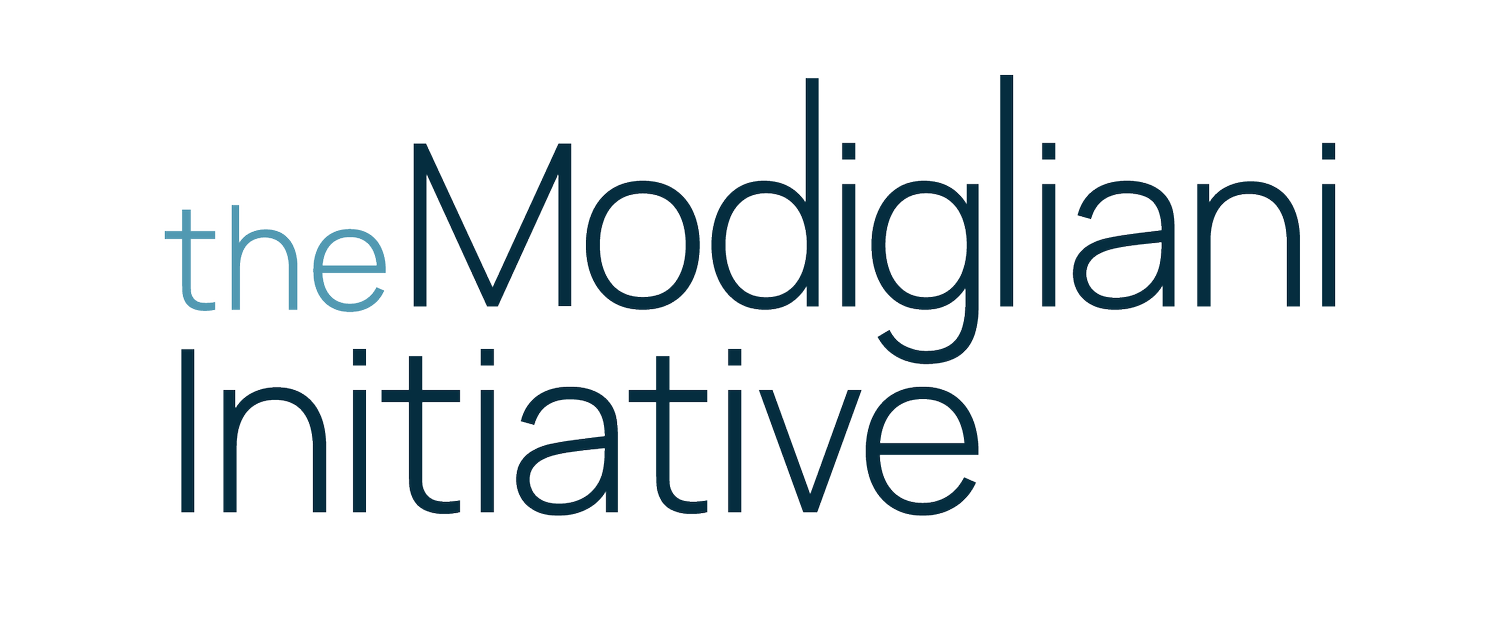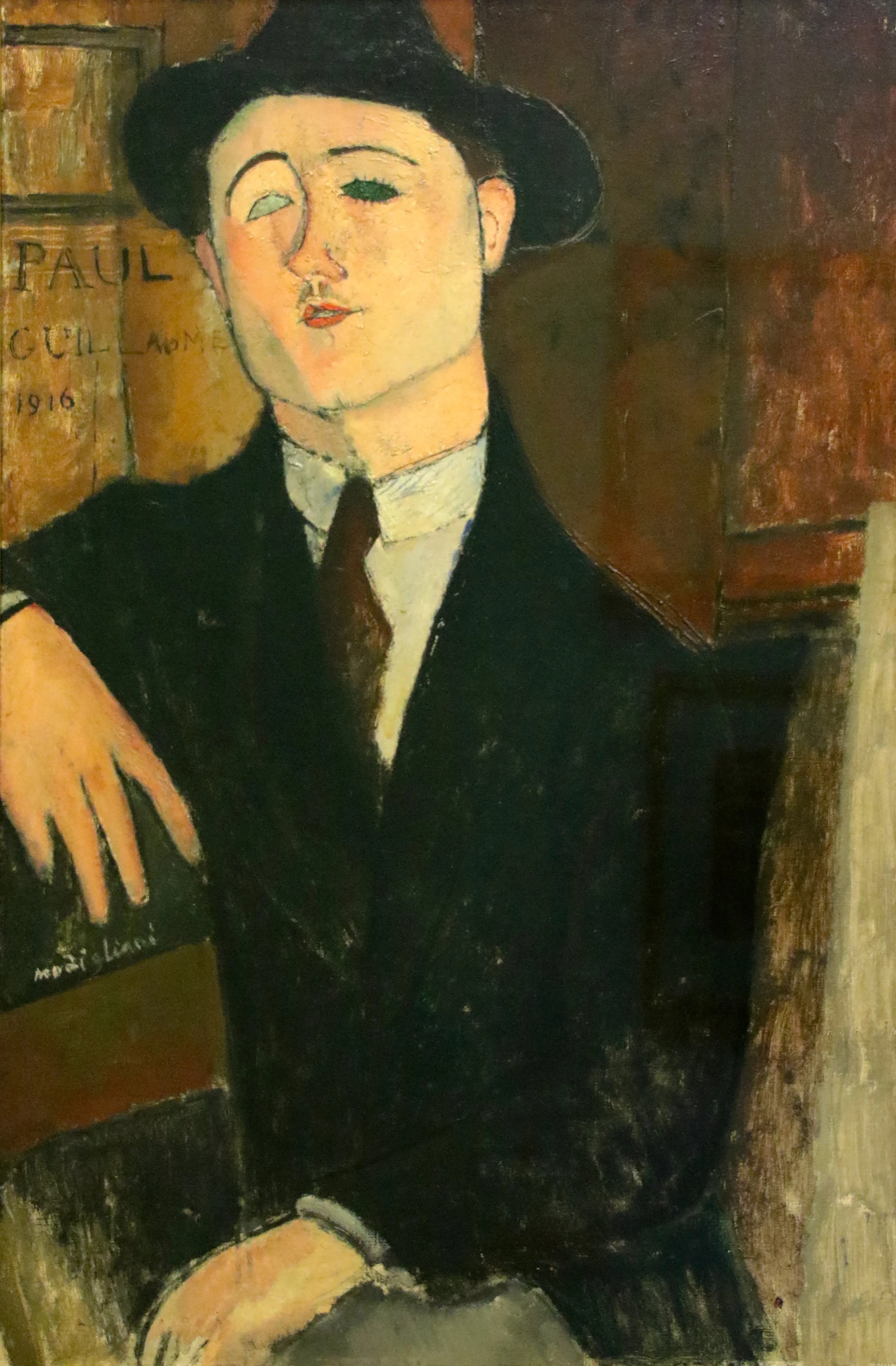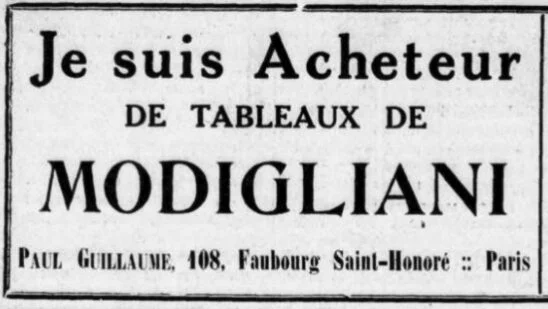“Peintres d’aujourd’hui”
Modigliani at the Galerie Paul Guillaume
June 27, 2023
The poet Max Jacob introduced Paul Guillaume to Modigliani probably in late 1914. Guillaume then became the artist’s primary dealer and took credit for Modigliani’s shift from sculpture to painting.[1] The artist duly produced four portraits of his new agent, three of which are dated on the front: 1915, September 1915, and 1916, roughly documenting the period of their alliance. (Figs. 1–4) Curiously, though he acquired a substantial number of paintings from the artist during this time, Guillaume never organized a solo exhibition for Modigliani.
Figs. 1–4: L to R, top to bottom: 1) Paul Guillaume, Novo Pilota, 1915, Oil on board, Musée de l'Orangerie, Paris; 2) Paul Guillaume, September 1915, Oil on board, Toledo Museum of Art, Ohio; 3) Paul Guillaume, 1916, Oil on canvas, Museo del Novecento, Milan; 4) Paul Guillaume, 1916, Oil on board, Private Collection.
Guillaume never organized a Modigliani exhibition
during the artist’s lifetime
The first time Guillaume displayed a selection from his Modigliani inventory was in November 1916, in the group show known as Lyre et Palette, an event that may also have marked the end of their partnership. The exhibition included paintings by Henri Matisse, Pablo Picasso, and Moïse Kisling, but the fourteen Modigliani paintings represented the largest group of works by a single artist. These remained unsold at the show’s closing, however, and the art critic Francis Carco later confirmed that Guillaume couldn’t find a buyer, “not even at 10 louis.”[2]
Guillaume’s failure to sell Modigliani’s work may have helped convince the dealer to relinquish his representation of the artist to Léopold Zborowski.[3] Around this time, the Polish-born, poet-turned-art-dealer began supplying Modigliani with art supplies and models, and, most importantly, paying him a regular stipend. It was Zborowski who organized the artist’s first solo exhibition which was held at Galerie B. Weill in December 1917.[4]
Meanwhile, Paul Guillaume’s business took off. In the fall of 1917, he opened a gallery on the elegant rue Faubourg du Saint-Honoré where, the following January, he ambitiously arranged the first joint exhibition of paintings by Matisse and Picasso. The enterprising dealer then launched his own magazine, Les Arts à Paris. He ended 1918 with Peintres d’aujourd’hui, an exhibition showcasing the works by what he believed were the leading contemporary painters of the time: Matisse, Picasso, Kisling, Giorgio de Chirico, André Derain, Roger de la Fresnaye, Maurice de Vlaminck, and Modigliani.
Modigliani’s inclusion in Peintres d’aujourd’hui suggests Guillaume’s renewed interest in the artist
By 1918, Scandinavian dealers and collectors had discovered and begun buying Modigliani’s paintings. The Swedish dealer Gösta Olson, who considered Modigliani a “fascinating artist,” acquired around fifteen portraits and nudes in Paris before returning to Stockholm and opening the Svensk-Franska Konstgalleriet (Swedish-French Art Gallery) that November.[5] Christian Tetzen-Lund, the Danish collector, bought his first Modigliani painting from Paul Guillaume in late 1918.[6] Recognizing a burgeoning market for the artist, Guillaume was inspired to purchase Femme au voile, a more recent Modigliani painting that he included in Peintres d’aujourd’hui, among examples of the artist’s earlier works. This turned out to be a shrewd decision on Guillaume’s part because Tetzen-Lund then acquired Femme au voile from the exhibition.[7] (See below for more on the Peintres d’aujourd’hui exhibition.)
Paul Guillaume became wholly committed to Modigliani’s work after the artist’s death
Le Crapouillot (February 1, 1920): 24.
Guillaume was instrumental in Modigliani’s decision to focus on painting and helped boost his career by presenting him as one of the most important painters of the day. It wasn’t until after the artist’s death, however, that Guillaume began to take a more active role in promoting his work. In fact, it was just days after the funeral when the dealer began advertising that he was buying Modigliani paintings; he quickly earned a reputation for paying top prices.[8] While Paul Guillaume was an early supporter, his crucial efforts to establish Modigliani’s international reputation largely took place posthumously.
Julia May Boddewyn
Endnotes
Paul Guillaume, “Lettre ouverte à M. Francis Carco,” Les Arts à Paris, no. 13 (June 1927): 22. Confirming the artist’s increased painting production, only one portrait is dated 1914 on the front [Ceroni 45] whereas seven are dated 1915 [Ceroni 56, 57, 71, 79, 81, 100, and 101].
Francis Carco, L’ami de peintres (Paris: Gallimard, 1953), 35. If Carco’s quote is to be taken literally, one louis was worth 20 francs. At the time 10 louis was equivalent to about $34, according to David M. Challis, Archival Currency Converter, 1916–1940.
Modigliani’s first portrait of Zborowski is likely Ceroni 157, which is inscribed with both the poet’s name and the year: 1916. Notably, this is on canvas, instead of cardboard, the less costly material that Modigliani often used for his earlier portraits.
For more on Modigliani’s first solo exhibition at the Galerie B. Weill, see my Modigliani Reconsidered essay here.
Gösta Olson, Fran Ling till Picasso. En konsthandlares minnen (From Ling to Picasso. An Art Dealer Remembers). (Stockholm: Ed. Albert Bonniers, 1965), 99. Special thanks to Christina Brandberg who not only shared excerpts of Olson’s memoir, but provided the translation. Email dated January 31, 2023.
Tetzen-Lund acquired Adrienne (Woman with Bangs), 1917, from Guillaume in November or December 1918. Email from Jesper Svenningsen to Leslie Koot, September 24, 2021. Today this painting is in the collection of the National Gallery of Art, Washington, D.C.
For more on Femme au voile, see Leslie Koot’s essay: “Reconsidering a Portrait Not Included in Ceroni.”
Guillaume actually advertised that he paid high prices for Modigliani’s paintings: “J’achète cher actuellement les tableaux de Modigliani.” Le Crapouillot (January 15, 1921): 20.
Reconstructing the December 1918 exhibition
Peintres d’aujourd’hui
at the Galerie Paul Guillaume
Checklist of Peintres d’Aujourd’hui, published in Les Arts à Paris (December 15, 1918): 10.
L to R, top to bottom: 24) Femme au voile, 1918, Dallas Museum of Art; 25) La jolie Ménagère, 1915, Barnes Foundation, Philadelphia; 26) Madame Pompadour, 1915, Art Institute of Chicago; 27) Béatrice [Likely Beatrice (Portrait de Béatrice Hastings), 1916, Barnes Foundation, Philadelphia.
The titles for the three early works appear to have come directly from the paintings
The Modigliani Initiative















